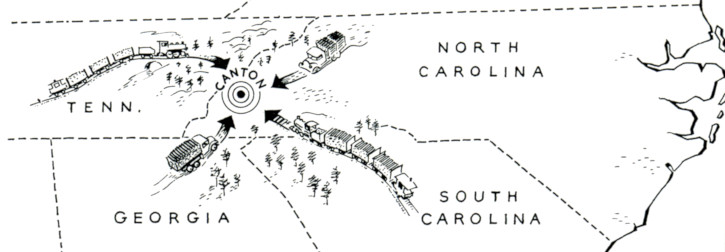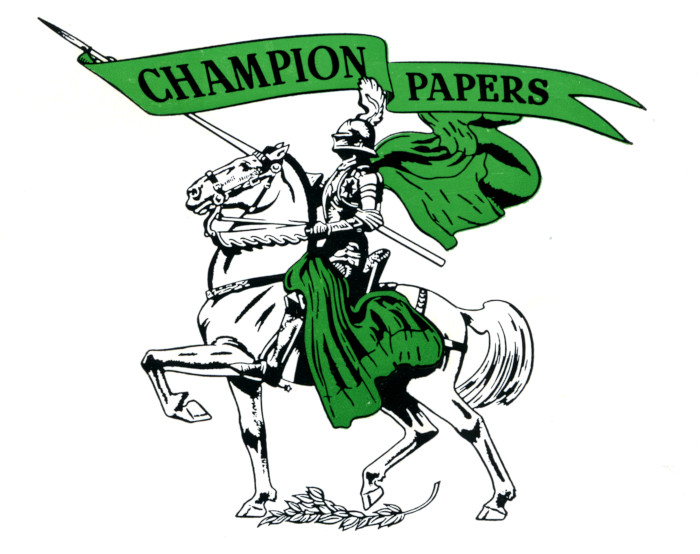Champion Pulp and Paper Mill in Canton, NC, Timeline
Tweet ShareLocated just west of Asheville, North Carolina, and within the headwaters of the Pigeon River, is the small town of Canton, home to the Evergreen Packaging mill, an employee-owned facility. Opened in 1908 as the Champion Fibre Company, the pulp and paper mill has played a significant role in the environmental and social history in this part of the Southern Appalachians. On the one hand, the mill has been an economic engine for Canton for more than a century. However, it has also been contributing to the contamination of the westward flowing Pigeon River and sending its sulfur-rich odor to its downwind neighbors since it began operating. Over the course of its lifetime, no matter who has owned it, the mill has had a major impact on area natural resources through activities including timber harvesting, paper production, and product conversion.

The Champion Fibre Company mill in Canton, circa 1911.
This chronology documents the mill in Canton and the major events relevant to the mill’s influence on the town and region. The links connect to more information or relevant historical material held at the Forest History Society in Durham, NC.
| 1893 | The town of Pigeon River, North Carolina, is reincorporated by the state’s General Assembly as Canton.
Peter G. Thomson of Hamilton, Ohio, incorporates the Champion Coated Paper Company.  Champion founder Peter G. Thomson |
| 1905 | Peter Thomson purchases thousands of acres of virgin timberland in and around the Pigeon River headwaters.
The chestnut blight is introduced to North America through nursery stock and first found on the grounds of the Bronx Zoo in New York. The fungus will spread quickly and eventually eradicate the American chestnut from North American forests in less than 50 years. 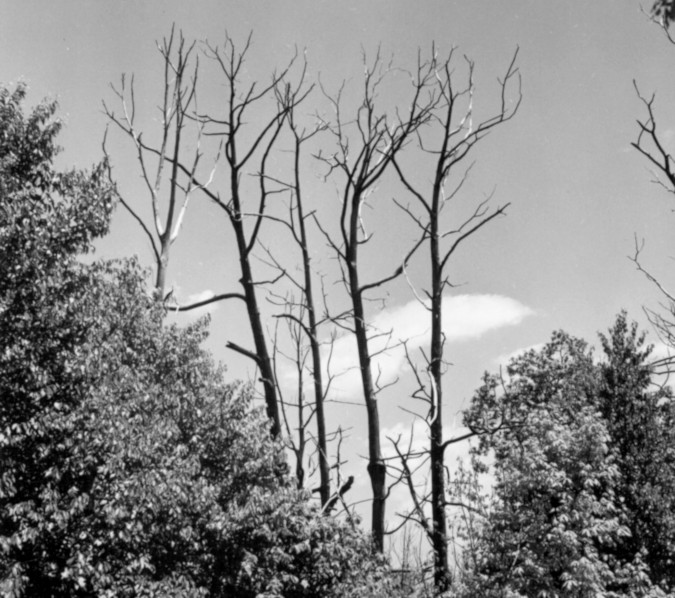 A group of blight-killed chestnut trees in North Carolina. |
| 1906 | Construction of Champion Fibre Company in Canton begins. The location was chosen due to the large supply of timber for pulp fiber, access to water, and rail access to promising markets.
|
| 1907 | The new mill brings legislative change even before opening. Chapter 298 of the public laws of 1907 (“An Act to Encourage the Building of Pulp Mills and Paper-mills and Tanneries in the Counties of Haywood and Swain”) amends the 1901 classification of polluters of the Pigeon River. The new law holds that only new facilities below the forks of the Pigeon River are accountable for their pollution, moving the designated point down river, conveniently below the location of the new Champion Fiber mill.
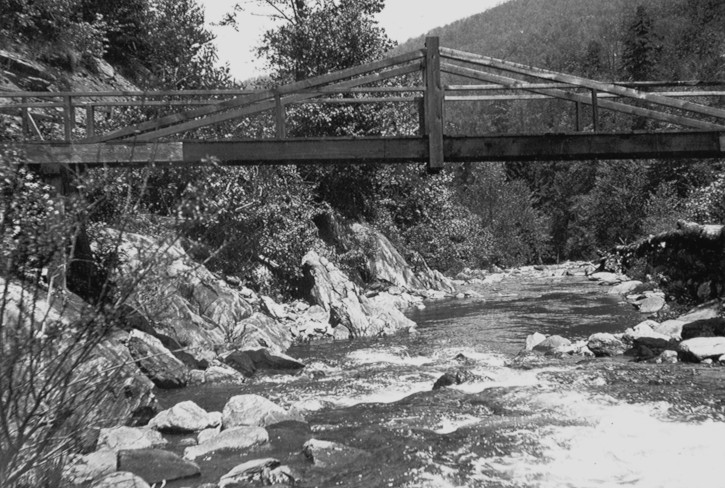 A bridge in the village of Sunburst across the Pigeon River, circa 1910. |
| 1908 | The Champion mill in Canton begins production in January. The mill is the first in the world to make white pulp from chestnut wood. The tanning material is separated from the fiber and sold to the leather industry.
The company also builds 60 small dwellings for some of the workers and their families, which came to be known as Fiberville. 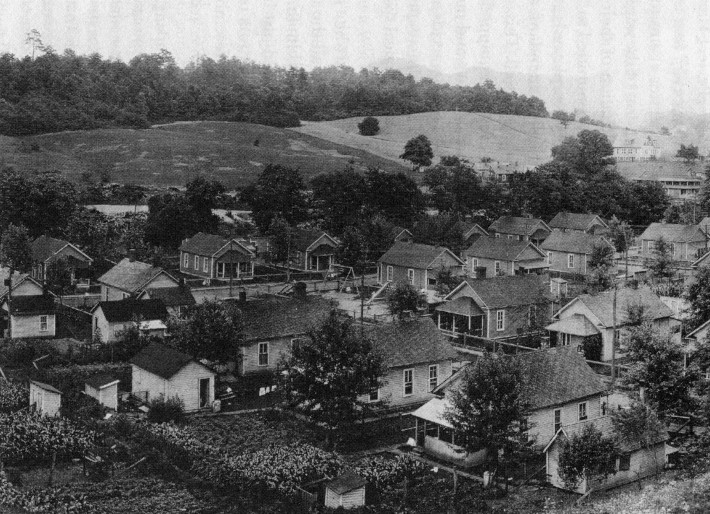 The company town of Fibreville (Snug Harbor photo). Reuben B. Robertson Sr., Peter G. Thomson’s son-in-law, becomes general manager of Champion Fiber Company in Canton. |
| 1910 | Spurred by the mill’s demand for workers, the population of Canton grows more than five-fold in just ten years. The population goes from just 230 residents in 1900 to 1,393 in 1910. |
| 1911 | President Taft signs The Weeks Act, which enables the U.S. government to purchase private land in order to protect the headwaters of navigable waterways. In the short term, it proves vital for conserving important environmental and ecological features of Appalachian forests. By protecting more than 20 million acres, mostly in the eastern U.S., the law will become one of the most influential pieces of legislation in the country.
Champion Fibre Company sells part of its timber holdings to Champion Lumber Company (they were separate companies). Champion Lumber Company begins operating a lumber mill at Sunburst, NC (the town of Sunburst was about 12 miles southwest of Canton). 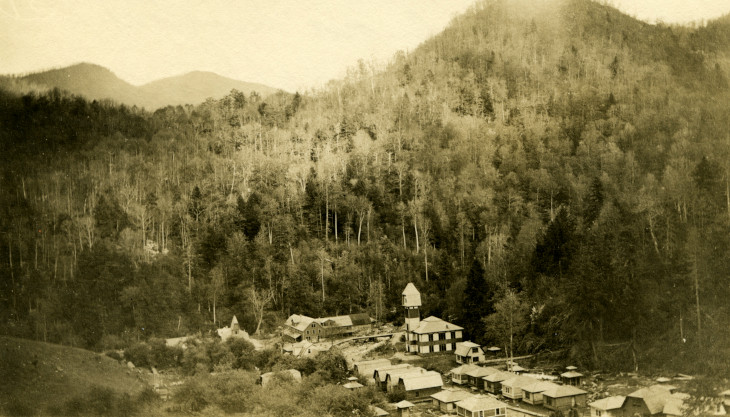 Sunburst, North Carolina, circa 1910. |
| 1912 |
In the April 18 issue of Plain Talk, the weekly newspaper of Newport, Tennessee, the news of the Titanic’s sinking on April 15 is relegated to page two. But Champion Fibre’s announcement that new technology was being implemented to reduce pollution makes the front page. The company, however, continued to insist that the byproducts being discharged into the Pigeon River were harmless. |
| 1916 | The Pisgah National Forest is established in southwestern North Carolina, with nearly 86,000 acres of forestland purchased from the Vanderbilt family. Pisgah is the first national forest created under the Weeks Act. From 1898 to 1909, Vanderbilt’s Biltmore Estate was home to the Biltmore Forest School, the first forestry school in the country. When the school’s founder Carl Schenck was fired by Vanderbilt, he moved his school to Sunburst, NC, before the lumber mill opened there. Schenck initially failed to persuade Peter Thomson to initiate forest management on Champion Fibre’s lands.
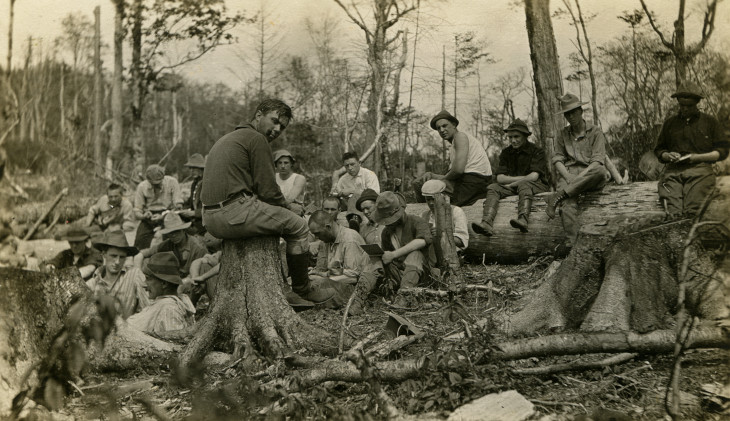 A group of Biltmore Forest School students in the woods. |
| 1920 | Reuben Robertson hires Walter Damtoft of the U.S. Forest Service as chief forester at Champion Fibre’s Canton mill. Damtoft is considered the first professional forester employed by a pulp and paper company in the U.S. Southeast.
On April 20, 1920 the Champion YMCA was dedicated by Mr. Peter G. Thomson, the organizer and first President of Champion Fibre Co. The cost of this building, $75,000, was his gift to the enrichment of the cultural, educational, recreational and spiritual life of the Canton community. From its beginning the facilities and activities of the YMCA were planned for men, women, boys and girls to provide entertainment, education and physical training for both Champion employees, their families and the citizens of the Canton area at a moderate membership rate. This program has enjoyed the support of Champion Papers Inc. 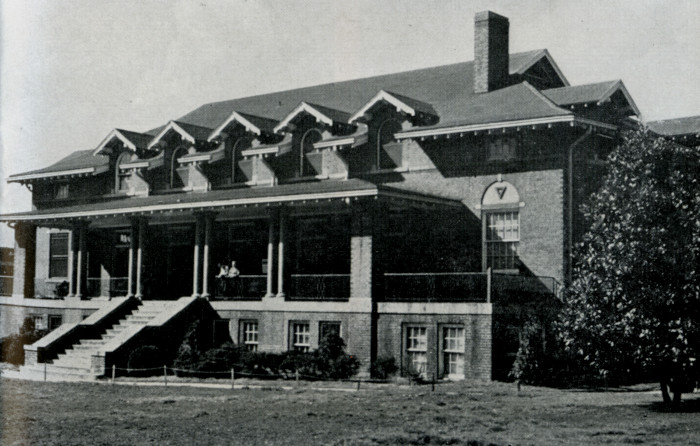 YMCA building in Canton. |
| 1922 | Paper production from southern pine begins at the Canton mill. The mill installs the first book paper mill in the U.S. South. |
| 1924 | Champion workers in Canton strike for a three-shift day and competitive wages. After a union attempted to organize the workers, mill management promised eight-hour shifts, an adequate pay scale for those who turned in their union cards, and no repercussions. |
| 1925 | The Champion Knight logo appears on a shipment of paper for the first time. The Canton mill also begins producing paper from the bleached sulfate pine pulp.
|
| 1929 | Champion Fibre Company buys the land around Sunburst to create a reservoir. When the dam was completed in 1932, the reservoir water flooded the area to form Lake Logan, named after Peter Thompson’s son, Logan. |
| 1931 | Peter G. Thomson, founder of Champion, dies.
Champion Fibre Company sells around 90,000 acres of private forestland to the U.S. government. The lumber had been used for harvesting timber used in producing fiber for the mill. This land eventually becomes part of the Great Smoky Mountains National Park. The sale price of $3 million allows the Canton mill to purchase new plant equipment, and ultimately sustain production through the Great Depression. |
| 1933 | The Canton mill installs the world’s largest book paper machine at that time. |
| 1934 | The Canton mill begins producing high-quality white pulp from southern pine, the first operation to do so. This was made possible by a multi-stage bleachery, and eventually led to Canton being the first U.S. mill to manufacture bleached hardwood pulp cooked by the sulfate process.
 Pulp being washed after bleaching at Canton mill. |
| 1935 | The Hamilton, Ohio, and Canton operations are merged to form the Champion Paper and Fibre Company. |
| 1937 | Champion Fibre erects a new facility in Pasadena, Texas, that uses the sulphate bleaching technology originally developed at the Canton mill. |
| 1940 | Two of the largest floods on record hit Canton and the Champion mill within two weeks of one another. The mill is shut down for 100 hours and damage to the town is estimated at $303,000.
In the same year, a magazine coated paper machine is installed in Canton, followed by a board machine and a new paper machine. |
| 1946 | Reuben B. Robertson Sr. succeeds Logan G. Thomson as Champion’s president. |
| 1947 | An even larger book paper machine is installed, increasing production from the machine installed in 1933. |
| 1950 | Reuben B. Robertson Jr. succeeds his father as the company’s president.
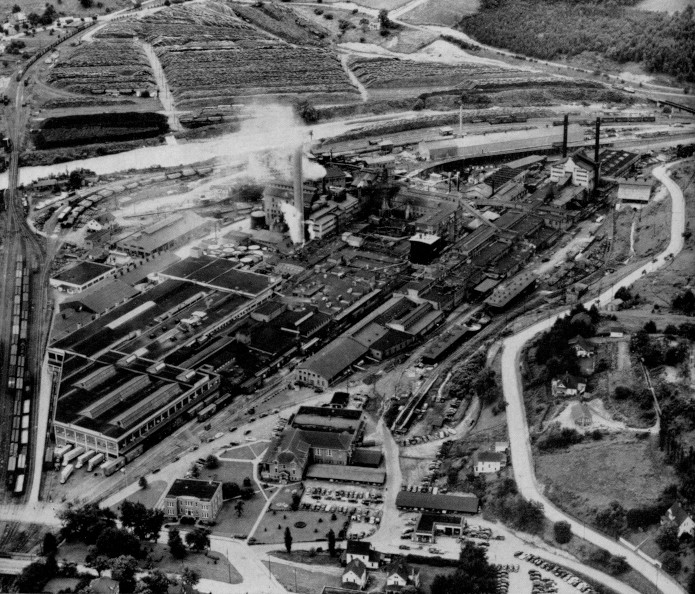 Aerial view of the Canton mill, early 1950s. |
| 1951 | The Canton Extract Plant, which separated tanning materials from the chestnut fibers, is abandoned due to the dropping supply of chestnut wood as a result of the blight introduced in 1905. |
| 1960 | Reuben B. Robertson Jr. is killed in a traffic accident in Cincinnati, Ohio. This sparks major changes in the Champion organization and marked the decline of the Thomson-Robertson family control over the company. |
| 1965 | The Robertson Memorial YMCA opens in Canton, a symbol of the Robertson family’s influence on the community as well as the paternalism the mill exerted over its employees.
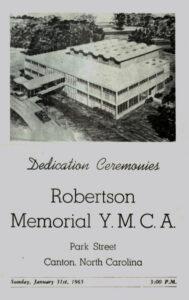 Program details the events of the dedication ceremony for the Robertson Memorial Y. M. C. A, via Western Carolina University |
| 1967 | Champion merges with U.S. Plywood in an effort to restore profitable operations and consolidate timber resources. The new company is called U.S. Plywood–Champion Papers for the next 5 years. |
| 1972 | The company is renamed Champion International Corporation.
Congress passes the Clean Water Act. The law is amended in 1977 to better regulate “the discharge of untreated wastewater from municipalities, industries, and businesses into rivers, lakes and coastal waters.” |
| 1983 |
First major litigation case against Champion’s Canton mill pollution is brought by the State of Tennessee. |
| 1984 | Champion International acquires St. Regis Corporation for $1.6 billion, which greatly increases their capacity for producing newsprint and magazine paper. With the acquisition, Champion International now owns 6.4 million acres in the U.S. and Canada, making it one of the largest private landowners in North America. Champion also has landholdings in Brazil at this time. |
| 1990 | Wall Street tycoons Warren Buffet, Laurence Tisch, and John Templeton purchase hundreds of thousands of shares in Champion Corporation, sparking fear in the town that the company would soon be acquired. |
| 1992 | There are 1,714 employees working at the Canton paper mill and an additional 251 workers at the Waynesville conversion facility. During this time the Canton mill is a major coated paper producer for Life magazine. |
| 1994 |
Champion announces that it will be implementing a new bleaching technology, costing around $30 million, that would be used to further clean the Pigeon River, which the Canton mill had been polluting for nearly a century. |
| 1999 | The employees of the Canton operation purchase the mill and rename the company Blue Ridge Paper, Inc. Champion sold the Canton mill and other operations to the employees in a $200 million buyout led by the workers’ union. Blue Ridge Paper was a large regional producer of envelope, writing, and printing papers, as well as packaging products. |
| 2006 | The mill transfers owners once again and is renamed Evergreen Packaging. |
| 2020 |
Evergreen Packaging and Pactiv, part of Reynolds Group Holdings Limited, come together to create a public offering under the name Pactiv Evergreen. |
| 2021 |
Torrential rains from Tropical Storm Fred bring deadly flash floods to the North Carolina Mountains. One of the hardest hit areas is Canton, with significant damage to homes and businesses. |
| 2023 |
Pactiv Evergreen announces closure of the mill in Canton as part of a restructuring plan. |
During the transition from Champion International to Blue Ridge Paper to Evergreen Packaging, the Canton mill remained in operation without interruption. The mill sold its timberland to West Fraser Timber Company soon after becoming Evergreen. Today the mill operates on about 200 acres in downtown Canton, with a conversion facility in nearby Waynesville. Evergreen employs around 1,000 people and produces liquid packaging, commercial paper, cupstock, and a variety of other papers and boards.
While driving alongside the Pigeon River west of Asheville on I-40, one can see the mill and smell the sulfur as well as the river, which is still used as the mill’s primary water supply, offering reminders of mill’s ongoing presence and impact. Canton continues to build on its legacy as one of the premier U.S. mill towns, and the mill at the town’s center continues its symbiotic relationship with the southern Appalachian forests of North Carolina.
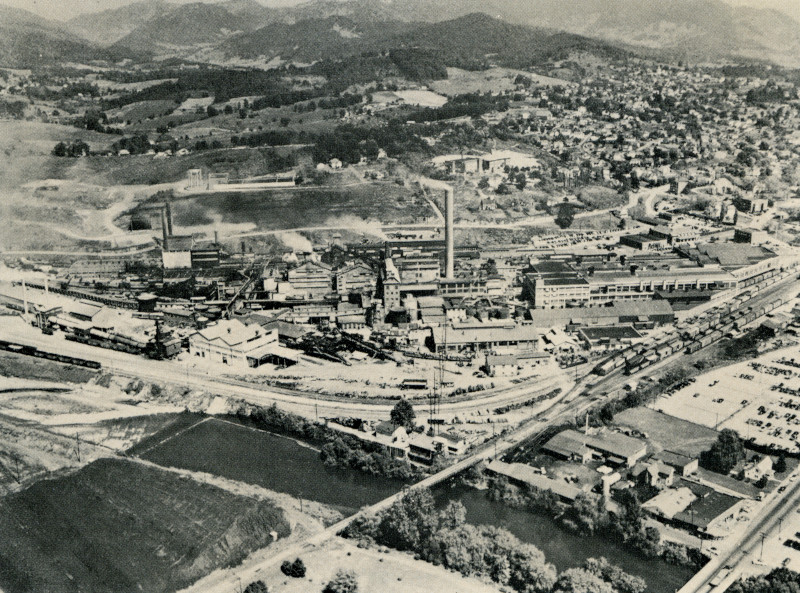
Aerial view of Canton, NC, taken in 1958.
Additional Resources
Detailed art rendering of the paper-making process at the Champion mill in Canton.
Damtoft, W. J. “A Half Century of Forestry in a Democracy.” 1950 pamphlet from American Forest Products Industries.
Garrett, Ray. “In Less Than a Life Span.” American Forests 58 (October 1952): 23-25.
The Story of the Carolina Division. Canton, NC: The Champion Paper and Fibre Company. Circa 1956.
“Champion Started Its WNC Operations 51 Years Ago.” Asheville Citizen-Times, Asheville, NC (January 27, 1957): E9.
“The Story of Papermaking: How Champion Papers are Made.” from This is Champion, a 1958 promotional booklet by Champion Paper and Fibre Company: 47-57.
Oral history interview with Reuben B. Robertson and E. L. Demmon. Interview by Elwood Maunder in Asheville, NC, February 15, 1959.
Oral history interview with Walter J. Damtoft. Interview by Elwood Maunder in Asheville, NC, February 14-15, 1959.
Maunder, Elwood R. and Elwood L. Demmon. “Trailblazing in the Southern Paper Industry: An Interview with Reuben B. Robertson.” Forest History Newsletter 5 (Spring 1961): 6-12.
Bartlett, Richard. “The River and Time: Pigeon’s Toxic Past.” Forum for Applied Research and Public Policy 11 (Winter 1996): 88-91.
Whitlock, Craig. “Upstream Friend, Downstream Foe.” News and Observer, Raleigh, NC (April 20, 1997): 1B, 4B.
Whitlock, Craig and Kyle Marshall. “River-Polluting Paper Plant Will Be Sold.” News and Observer, Raleigh, NC (October 9, 1997): 3A.
Walter J. Damtoft Papers, Forest History Society Archives.
Champion International Corporation Image Collection, Forest History Society Archives.
Additional Champion International Corporation historical material can be be found at the Forest History Society.
Other Historical Information Sources
Champion Paper and Fibre Company (NCpedia).
Champion and Blue Ridge Paper Timeline (Smoky Mountain News).
“Champion Paper.” Fortune (January 1949): 80-85.
Champion Paper, Inc., Canton Division. “From Forest to Finished Product.” 1953.
Bartlett, Richard A. Troubled Waters: Champion International and the Pigeon River Controversy. Knoxville: University of Tennessee Press, 1995.
Robertson, Peter Thomson. “Canton Mill Closure is a Devastating Blow.” The Mountaineer (March 7, 2023).

